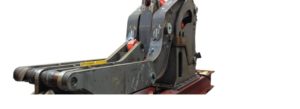August 12, 2016

There is a need for shortening the design and development time spans of new products in the Finnish machinery industry. One way to shorten the time to market is introduce modern integrated digital design tools to support the machinery industry´s product design and development. As a result of the development work done under FIMECC MANU programme new digital fatigue strength verification methods and concepts were developed.
An area where the need for the integrated digital design tools emerges particularly is the fatigue design of welded machinery structures with long service life and high structural and operational reliability requirements. The understanding of the fatigue of welded structures is especially important in a case of novel high-strength steel grades as advanced high-strength steels would bring significant benefits for machineries in terms of lighter and harder structures but as a same time present challenges to welding processes. As a result of the development work done in FIMECC MANU programme new digital fatigue strength verification tools for welds were developed.
In FIMECC MANU programme a new boom structure utilizing high strength steel and new welding methods was designed. The successful introduction of high-strength steel material into boom structure enable a lighter, stronger and more efficient equipment with higher payloads and lower fuel consumption. Lightweight boom construction using high-strength steel material enormously reduced the structural dead weight and increased the lift capacities. The total weight saving was 700 kg which is 25 % of the boom structure. The new boom structure has also reduced number of parts, less welding kilos and increased robot weldability which decreases the overall production costs.
As a part of new boom structure development a new digital fatigue strength verification tools for fatigue-critical welded structures based on the identification of true weld quality were developed. FE modelling and crack analyses for welds as part of the component physical accelerated fatigue testing was done in order to model the mechanical properties of the welded joints of the high-strength steels. Comparison between FEM predicted fracture initiation locations and true fatigue failure locations based on fracture surface analysis verified that the new fatigue stress simulation tools works and the results converge with outcome from very heavy testing program.
Modern integrated digital design tools, such as developed fatigue stress simulation methods, shorten the design and development time spans of new products and offer new tools for designers increasing the competitiveness of the Finnish machinery industry. The role of modern integrated digital design tools is especially important in the fatigue design of welded machinery structures with long service life and high structural and operational reliability requirements.
The importance of fatigue behavior optimization is further emphasized by the recent structural material developments, e.g. introduction of novel high-strength steel grades, and the related attempts for lightweight machinery solutions. Rising fuel prices and environmental issues combined to push machine manufacturers into developing lightweight machines. Novel high-strength steel grades allows meeting of these goals in an economically feasible manner. However, high-strength steel presents challenges to welding processes. In order to deploy the benefits of the recent structural material developments digital fatigue stress simulation tools for fatigue-critical welded structures are needed. The digital fatigue strength simulation methods reduces the time consuming and expensive fatigue stress test programs supporting new product development and enabling the testing of new product features.
The development work done in FIMECC MANU programme enabled the development of the new fatigue stress simulation tools for fatigue-critical welded structures. Furthermore, the methods developed were verified and according to the results the model converge with outcome from very heavy testing program.
Full digital fatigue strength simulation tools speed up R&D cycles dramatically saving money and shortening time-to-market. Moreover, solid modeling provide new way to analyze product versions for final selection and enable the development of new products with greater operational flexibility and lower production costs. The new methods will be further utilized, for example in Sandvik’s new product development process.
Overall, considerable benefits will be gained through the shortened time-to-market, more precise design that leads into savings in material resource usage and production efforts during manufacture, as well as more economic operating costs through the product service life. On the other hand, failure avoidance through improved fatigue design and the resulting safe and uninterrupted operation decrease the product life-cycle costs even further.
